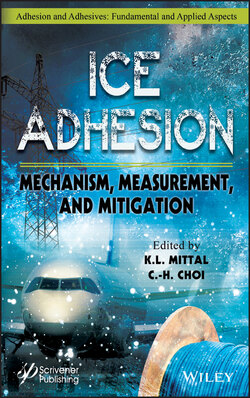Читать книгу Ice Adhesion - Группа авторов - Страница 33
2.2 Classical Nucleation Theory
ОглавлениеUp to now, classical nucleation theory (CNT) is still the theory most widely used to quantitatively describe the kinetics of nucleation. This theory was established based on two major assumptions: (1) the nuclei (i.e., embryos) can be regarded as spherical clusters, which possess the macroscopic densities and surface tensions, and (2) their distribution follows a Boltzmann statistics.
In water vapor there are always clusters of a few molecules which exist due to random agglomeration of molecules. These agglomerates constantly form and decay. When the system is in a metastable, supersaturated state, such clusters should, in principle, be energetically favored because the chemical potential of a molecule within the cluster is lower than in the vapor phase. However, cluster formation also leads to the existence of a liquid-vapor interface, which inevitably leads to an energy penalty – the interfacial energy – for forming this interface. Therefore, whether such a cluster can develop into a nucleation embryo depends on the relative magnitudes of these two energy contributions. The change of Gibbs free energy ∆G for forming a cluster containing n molecules can be expressed as,
(2.1)
in which, Δµ is the change in chemical potential for a molecule on moving from the vapor phase (denoted by subscript 1) to the liquid phase (denoted by subscript 2). A and σ1,2 denote the area of interface and the surface tension between liquid and vapor phases, respectively. σ1,2 A is the energy required to create the interface between condensed and vapor phases.
For simplicity, it is more convenient to express the properties of a cluster in terms of its radius, r. Assuming that the cluster is spherical due to surface tension, its volume is is the volume of a molecule in the condensed phase. The required energy for cluster formation is,
(2.2)
where is the Gibbs free energy difference per unit volume, which can be calculated using Gibbs-Helmholtz equation,
(2.3)
where kB is Boltzmann constant, S1,2 is supersaturation ratio between original phase and new phase, p1 is the actual pressure of original phase, and p2 is the saturation pressure of new phase at temperature T.
The total free energy change ∆G(r) is a balance between by two ‘competitive’ factors, the volume free energy and the interfacial energy due to the formation of new phase, as demonstrated in Eq. 2.2. If the system temperature is below the saturation point T < Ts, i.e., the original phase is supersaturated, the chemical potential difference ∆μ < 0, while the interfacial free energy is always positive. As the volume of cluster scales with r3 and the interfacial area scales with r2, the interfacial free energy dominates ∆G(r) in the limit of small clusters. For a sufficiently large cluster, however, the volumetric term is dominant, leading to a negative ∆G(r) < 0. Therefore, the maximum energy penalty as a function of cluster radius can be readily obtained by solving d∆G(r)/dr = 0, giving the critical radius (r*) of a cluster, which on further growth leads to decrease in ∆G(r) and will then lead to nucleation:
(2.4)
And the critical nucleation barrier ∆G* is given by,
(2.5)
The nucleation process shown in Figure 2.1 can be understood in two thermodynamic regimes: (1) the free molecules in the supersaturated original phase form small clusters. As the clusters grow, ∆G(r) increases (being dominated by the rapid increase in surface energy), implying that the cluster growth or the continuous nucleation in this regime is not thermodynamically favorable, i.e., most of the molecules return back into the original phase. This is why homogeneous nucleation needs high supersaturation or supercooling, making, e.g., possible the existence of supercooled water at 150 K [88]. (2) Once the clusters reach the critical nucleus size of r* and pass the barrier of ∆G(r*), further growth of the nucleus will lead to decrease in ∆G(r). Thus, the further nucleus growth will become thermodynamically favored and will eventually lead to new phase formation in bulk.
Figure 2.1 The dependence of the Gibbs free energy change ΔG on the nucleus radius r. The blue curve has a maximum free energy ΔG* at a critical nucleus radius r*, which defines the critical nucleation barrier.
